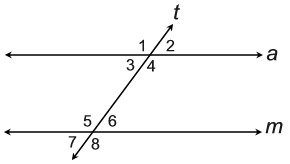The two vectors A and B in the figure have equal magnitudes of 13.5 m and the angles are θ1 = 33° and θ2 = 110°. How to find (a) the x component and (b) the y component of their vector sum R , (c) the magnitude of R, and (d) the angle R ?
1 Answer
Here's what I got.
Explanation:
I don't wave a good way of drawing you a diagram, so I'll try to walk you through the steps as they come along.
So, the idea here is that you can find the
For vector
#a_x = a * cos(theta_1)#
Likewise, the
#a_y = a * sin(theta_1)#
For vector
The angle between
#theta_3 = 180^@ - theta_2 = 180^@ - 110^@ = 70^@#
Draw a parallel line to the

In your case, line
In this drawing,
The angle between
#180^@ - (theta_1 + theta_2) = 180^@ - 143^@ = 37^@#
This means that the
#b_x = b * cos(37^@)#
Now, because the angle between the
#90^@ - 37^@ = 53^@#
The
#b_y = b * sin(37^@)#
Now, keep in mind that the
#R_x = a_x + b_x#
#R_x = 13.5 * cos(33^@) - 13.5 * cos(37^@)#
#R_x = 13.5 * 0.04 = color(green)("0.54 m")#
The
#R_y = a_y + b_y#
#R_y = 13.5 * [sin(110^@) + sin(37^@)]#
#R_y = 13.5 * 1.542 = color(green)("20.82 m")#
The magnitude of
#R^2 = R_x^2 + R_y^2#
#R = sqrt(0.54""^2 + 20.82""^2)" m" = color(green)("20.83 m")#
To get the angle of
#tan(theta_R) = R_y/R_x implies theta_R = arctan(R_y/R_x)#
#theta_R = arctan((20.82color(red)(cancel(color(black)("m"))))/(0.54color(red)(cancel(color(black)("m"))))) = color(green)(88.6""^@)#

